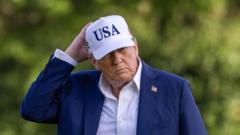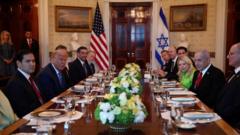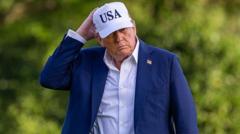President Trump's postponement of tariffs has not only highlighted the administration’s struggle to close trade deals but has also sparked tensions with key countries such as Japan and South Korea. The ongoing delays suggest a complicated and evolving trade environment as nations respond to the changing dynamics.
Trump's Tariff Delays Highlight Struggles in Trade Negotiations

Trump's Tariff Delays Highlight Struggles in Trade Negotiations
Amidst an uncertain global trade landscape, President Trump's delay in implementing tariffs reveals broader challenges in securing international trade agreements.
The announcement of a delay in imposing tariffs by President Trump’s administration has raised questions about the effectiveness of the United States' trade policy and its global repercussions. The initial ambition of securing "90 deals in 90 days" now appears overly optimistic, with deadlines pushed back from July 9 to August 1, indicating potential further delays ahead.
From the U.S. standpoint, Treasury Secretary Scott Bessent has emphasized focus on the 18 nations that account for nearly all of America's trade deficit. However, the communication sent to trading partners seems reminiscent of the past, without substantial progress. The overall sentiment in the markets is one of skepticism, as investors adopt the notion that Trump may falter in his commitments, though such expectations could unintentionally encourage further procrastination in negotiations leading to crises.
Meanwhile, reactions from international counterparts like Japan and South Korea reveal their discontent with the U.S. approach, with Japan's finance minister hinting at leveraging its substantial holdings of U.S. debt for negotiation advantage. This illustrates a significant shift wherein the U.S. is now faced with retaliatory stances from its trading partners.
In contrast to the early year’s market volatility prompting caution, the current trade figures suggest an evolving narrative. For example, while U.S. tariffs have caused a 9.7% decrease in Chinese exports to the U.S. this year, China has instead increased its trade with other global entities, highlighting a diversion in trade patterns as countries turn towards one another amidst U.S. tariffs.
Trade revenues are reportedly showing upticks, but the long-term effects of a rising tariff rate—which has jumped to around 15%—could disrupt established economic relationships. As nations like the UK and India, and the EU and Canada forge economic pacts, analysts remain vigilant about how these trends will shape the landscape of global trade and commerce moving forward.
As the situation develops, the potential instability in market responses and trade negotiations remains a significant focus for international observers and stakeholders alike, signifying that the global economic balance is still in flux.
From the U.S. standpoint, Treasury Secretary Scott Bessent has emphasized focus on the 18 nations that account for nearly all of America's trade deficit. However, the communication sent to trading partners seems reminiscent of the past, without substantial progress. The overall sentiment in the markets is one of skepticism, as investors adopt the notion that Trump may falter in his commitments, though such expectations could unintentionally encourage further procrastination in negotiations leading to crises.
Meanwhile, reactions from international counterparts like Japan and South Korea reveal their discontent with the U.S. approach, with Japan's finance minister hinting at leveraging its substantial holdings of U.S. debt for negotiation advantage. This illustrates a significant shift wherein the U.S. is now faced with retaliatory stances from its trading partners.
In contrast to the early year’s market volatility prompting caution, the current trade figures suggest an evolving narrative. For example, while U.S. tariffs have caused a 9.7% decrease in Chinese exports to the U.S. this year, China has instead increased its trade with other global entities, highlighting a diversion in trade patterns as countries turn towards one another amidst U.S. tariffs.
Trade revenues are reportedly showing upticks, but the long-term effects of a rising tariff rate—which has jumped to around 15%—could disrupt established economic relationships. As nations like the UK and India, and the EU and Canada forge economic pacts, analysts remain vigilant about how these trends will shape the landscape of global trade and commerce moving forward.
As the situation develops, the potential instability in market responses and trade negotiations remains a significant focus for international observers and stakeholders alike, signifying that the global economic balance is still in flux.




















